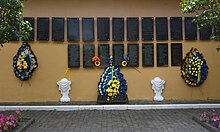NKVD prisoner massacre in Lutsk
With the onset of the occupation, the prison underwent expansions, including the addition of a surrounding wall, creating two internal courtyards separated by the main building of the former monastery.
Owing to the swift progression of the German offensive, the NKVD began the process of exterminating political prisoners held within the war zone.
Bogdan Musiał believes that the information about purported rebellion was contrived to justify the subsequent arbitrary liquidation of inmates, which took place the next day.
[11][b] Additionally, Filippov's report acknowledged that post the alleged suppression of the "rebellion," 73 prisoners previously sentenced to death before the war outbreak were executed.
[8] According to the report compiled by Sergeant of State Security Stan, head of the prison branch of the NKVD of the Volyn Oblast, on June 23 at 11:30 AM, an operational group led by Captain of State Security Rozov, composed of NKGB and NKVD officers from the Volyn Oblast, arrived at the prison.
Stan claimed that Rozov and the head of the local NKGB branch, Captain of State Security Ivan Belocerkovsky, instructed him to hand over, within 20 minutes, all prisoners detained under Article 54, points 2 and 11 of the Criminal Code of the Ukrainian SSR, specifically including members of the Organization of Ukrainian Nationalists.
Allegedly, the decision for immediate execution was influenced by erroneous reports suggesting that German troops were within 7 kilometers of Lutsk.
[12] Around noon,[8][13] guards instructed prisoners to vacate their cells with their belongings, implying imminent release due to the war's outbreak.
Upon compliance, Soviets revealed machine guns positioned in front of the prisoners, opening fire and hurling grenades into the crowd.
[16] In his report, Sergeant Stan claimed that the execution was carried out by members of the Rozov operational group, prison management, guards, and soldiers from the NKVD Convoy Troops company under the command of Senior Lieutenant Fakhrudinov.
[11] Surviving prisoners asserted that, alongside Soviet personnel, two Jewish women from Lutsk—Blumenkranz, approximately twenty years old (daughter of a shoe store owner), and a Spiegel—took part in the execution.
[17][f] Andrei Filippov's report indicated the shooting of two thousand individuals,[11] a number also mirrored in the "List of departures and movements of transports from NKVD prisons of the Ukrainian SSR".
[18] Among the victims, besides Ukrainians and Poles, were representatives of various nationalities, including ten German POWs captured by the Soviets and subsequently executed.
Investigations by the District Commission for the Prosecution of Crimes against the Polish Nation in Łódź revealed the names of 225 victims and 32 survivors.
Ultimately, the NKVD had aimed to eradicate all prisoners, but the entry of German troops into Lutsk on June 25, 1941, prevented this.
With German approval, Ukrainian residents of Lutsk constructed mounds atop four mass graves, marking them with plaques and oak crosses.
[8] Subsequently, on July 7, the "Völkischer Beobachter" published an article titled: "1,500 Ukrainians massacred by machine gun fire in Lutsk.
"[33] The day after the Germans took control of Lutsk, Ukrainian residents instigated a pogrom in which several Jews were killed and many others were wounded.
[36] In response to the revelation of Soviet massacres, particularly the deaths of German POWs, Field Marshal Walter von Reichenau ordered the execution of "as many Jews as Ukrainians previously killed".
[38][39] According to alternative sources, the number of Jews murdered in the city in late June and early July 1941 could have reached two thousand.
Scenes depicting the exhumation of victims murdered by the NKVD in the Lutsk prison serve as the opening for the novel The Kindly Ones by Jonathan Littell.


